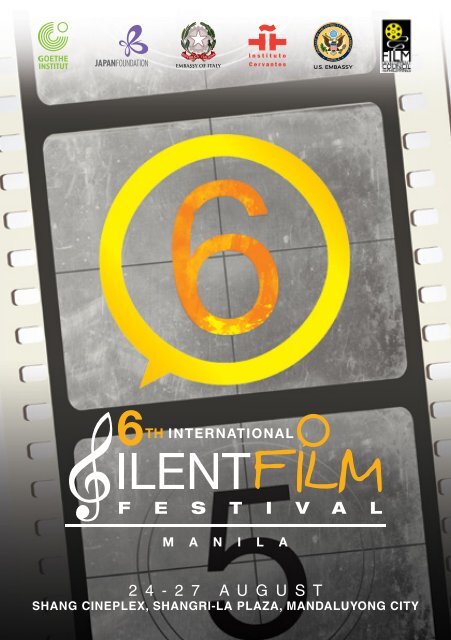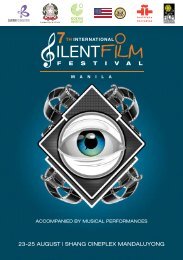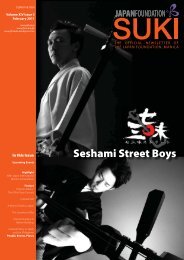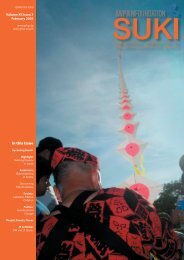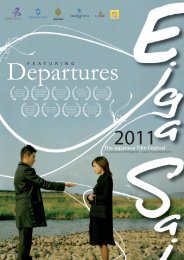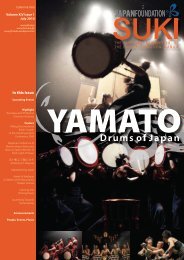Download 6th Intl Silent Film Brochure - The Japan Foundation ...
Download 6th Intl Silent Film Brochure - The Japan Foundation ...
Download 6th Intl Silent Film Brochure - The Japan Foundation ...
Create successful ePaper yourself
Turn your PDF publications into a flip-book with our unique Google optimized e-Paper software.
24-27 AUGUST<br />
SHANG CINEPLEX, SHANGRI-LA PLAZA, MANDALUYONG CITY
6TH INTERNATIONAL SILENT FILM FESTIVAL | MANILA<br />
INTRODUCTION<br />
RICHARD KÜNZEL 2007<br />
Since its inauguration in the year 2007 by the three<br />
founding partners Goethe-Institut, Instituto Cervantes and<br />
<strong>Japan</strong> <strong>Foundation</strong>, the <strong>Silent</strong> <strong>Film</strong> Festival grew fast during the<br />
following years, when the Embassies of the Czech Republic,<br />
France, Italy, and later Greece joined the group: In 2008 we were<br />
able to show 6 silent black and white films from the years 1914<br />
until 1933, accompanied live by 6 different Filipino groups of<br />
talented musicians.<br />
With the film THE BRIDES OF SULU we welcomed last year<br />
the first participation of a silent film from the Philippines and<br />
a group of musicians from Mindanao – thanks to the un-tiring<br />
research work of our friend, film historian and film enthusiast<br />
Teddy Co. Subsequently, silent films from the Philippines will<br />
continue to shape the face of this festival in this year with two<br />
entries by Raymond Red: “PELIKULA” (1985) and ETERNITY<br />
(1983).<br />
On behalf of my American, Italian, <strong>Japan</strong>ese and Spanish<br />
fellow organizers, I am proud to announce the participation of<br />
our new festival partner, the <strong>Film</strong> Development Council of the<br />
Philippines. With its Chairman, Mr. Briccio Santos, we signed<br />
last month a Memorandum of Agreement on cooperation in<br />
this exciting field of films, characterized by a very special film<br />
language that revives the charm of a long forgotten time with<br />
the help of very creative Filipino musicians and which pays<br />
tribute to a unique heritage of film culture by our Filipino and<br />
international partners involved.<br />
By the way, 100 years ago from today’s opening of the <strong>6th</strong><br />
International <strong>Silent</strong> <strong>Film</strong> Festival in Manila, the first full length<br />
feature film for theatrical release produced by the Philippines<br />
LA VIDA DE RIZAL, written and directed by Edward Meyer Gross<br />
had its world premiere on August 23, 1912.<br />
Last but not least, allow me to express our gratitude and<br />
thanks to the long standing excellent partnership with the<br />
management of the Shang Cineplex at Shangri-la Edsa.<br />
Wishing you all exciting viewings of the precious films being<br />
shown in the festival,<br />
Richard Künzel<br />
Director<br />
Goethe-Institut Philippinen<br />
SILENT FILM FESTIVAL TIMELINE<br />
ITALY<br />
Cabiria (1914)<br />
Music by<br />
Caliph8 (with Malek Lopez<br />
and Matt Deegan)<br />
FRANCE<br />
Visages d’enfants (1925)<br />
GERMANY<br />
Die Austernprinzessin (1925)<br />
Music by Noli Aurillo<br />
2009<br />
ITALY<br />
Assunta Spina (1914)<br />
Music by Caliph8<br />
GERMANY<br />
Berlin: Die Sinfonie<br />
der Grosstadt (1927)<br />
Music by Out of Body Special<br />
2011<br />
GERMANY<br />
Die Abenteuer des Prinzen Achmed (1926) Music by Drip<br />
SPAIN<br />
El sexto sentido (1929) Music by Wahijuara<br />
JAPAN<br />
Orochi (1925) Music by Makiling Ensemble<br />
SPAIN<br />
El negro que tenía<br />
el alma blanca (1926)<br />
Music by<br />
Novo Concertante Chorale<br />
JAPAN<br />
Taki-no-shiraito (1933)<br />
Music by Bob Aves<br />
CZECH REPUBLIC<br />
Erotikon (1929)<br />
ITALY<br />
L’uomo meccanico (1921)<br />
Music by Caliph8<br />
GERMANY<br />
Menschen am Sonntag (1930)<br />
Music by Nyko Maca<br />
SPAIN<br />
La bodega (1929)<br />
Music by Tanglaw<br />
JAPAN<br />
Kodakara Sodo (1935)<br />
Music by<br />
Radio Active Sago Project<br />
ITALY<br />
Dante’s Inferno (1911)<br />
Music by Razorback<br />
GERMANY<br />
Nosferatu (1922)<br />
Music by FEU Chorale and<br />
Stephan von Bothmer<br />
GREECE<br />
<strong>The</strong> Greek Miracle (1921)<br />
Music by Heliodoro<br />
(Dingdong) Fiel (HDC Trio)<br />
2008<br />
SPAIN<br />
La aldea maldita (1930)<br />
Music by Joey Ayala<br />
JAPAN<br />
Oatsurae Jirokichi Koshi (1931)<br />
Music by Kalayo<br />
FRANCE<br />
Fantomas: A l’ombre de la Guillotine (1925)<br />
Music by Corporate Lo-fi<br />
2010<br />
SPAIN<br />
Pilar Guerra (1926)<br />
Music by HDC Trio<br />
JAPAN<br />
Akeyuku Sora (1929)<br />
Music by Bandang Malaya<br />
PHILIPPINES<br />
Brides of Sulu (1934)<br />
Music by Armor Rapista<br />
and the Panday Pandikal<br />
Cultural Troupe
1927<br />
METROPOLIS<br />
FRIDAY 24 AUGUST, 7PM<br />
Director: Fritz Lang Cast: Brigitte Helm, Alfred Abel, Gustav Fröhlich, Rudolf Klein-Rogge<br />
Genre: Science Fiction Runtime: 143 Minutes<br />
Metropolis is a city in the<br />
future, with skyscrapers<br />
reaching for the sun and<br />
citizens, enjoying their prosperity<br />
under the rule of Johann Fredersen.<br />
His son Freder falls in love at first<br />
sight with Maria, a voice of the<br />
working class who came from the<br />
underground to end the separation<br />
of rich and poor. Through her,<br />
Freder discovers the price of<br />
his luxury: In the underground<br />
city, workers sacrifice their<br />
lives for the machines. Shocked<br />
Mit freundlicher Genehmigung von Transit <strong>Film</strong><br />
by his father’s governance, he<br />
swaps places with a worker<br />
and abandons his former life. In<br />
order to win back his son, Johann<br />
Fredersen instructs Rotwang,<br />
the inventor of Metropolis, to<br />
construct a robot which looks like<br />
Maria, to impeach her credibility<br />
as mediator between the classes.<br />
Encouraged by the mischievous<br />
robot, the workers start a rebellion<br />
bringing upper Metropolis close to<br />
its downfall.<br />
RSVP: Hannes - 817 09 78 or email: kultur.programm@manila.goethe.org<br />
HISTORY<br />
OF SILENT<br />
CINEMA IN<br />
GERMANY<br />
<strong>The</strong> history of German<br />
Stummfilm can be traced<br />
back to the hour of cinema’s<br />
birth. And even before the Lumière<br />
brothers first displayed their<br />
Cinématographe, in 1895 the<br />
German filmmakers Max and Emil<br />
Skladanowsky presented silent<br />
films to the public in Berlin, using<br />
their self-constructed film projector.<br />
Although sound could have been<br />
added earlier, film production was<br />
costly and the addition of sound<br />
impractical. However, silent films<br />
never have been presented in silence.<br />
In fact, musical accompaniment was<br />
central to German Stummfilm, as<br />
filmmakers were eager to explore<br />
their potential to transform films<br />
into a modern Gesamtkunstwerk<br />
combining different forms of art<br />
such as acting, storytelling and<br />
music. Until the assertion of sound<br />
in 1928/29, the Golden Age of<br />
German Stummfilm and the rise of<br />
German Expressionism brought up<br />
films like Nosferatu, Das Cabinet des<br />
Dr.Caligari, and Metropolis which<br />
are testament to the innovation and<br />
creativity of that time.<br />
RUBBER INC.<br />
Formed in 1998 by Malek Lopez<br />
and Noel de Brackinghe, Rubber<br />
Inc. successfully pioneered the<br />
concept of live dance music in<br />
the Philippines. Often confused<br />
with DJs the duo originally<br />
utilized an arsenal of keyboards,<br />
mixers, effects, and samplers<br />
to create music with a very<br />
distinct sound that incorporates<br />
elements of techno, house,<br />
latin, drum n’ bass, and the<br />
more leftfield sounds of groups<br />
like Aphex Twin. Not limiting<br />
themselves to the dancefloor,<br />
Rubber Inc. have done numerous<br />
gigs including performances,<br />
sound design, and soundtrack<br />
work. With Malek focusing on<br />
scoring projects for television,<br />
film and art exhibits. Noel<br />
spent his time honing his skills<br />
as an audio engineer and has<br />
produced or engineered many<br />
highly acclaimed albums. With<br />
the years of studio experience<br />
and the advancements in music<br />
technology the band have a<br />
whole new set of tools and skills<br />
that has advanced the bands<br />
sound and production.<br />
6TH INTERNATIONAL SILENT FILM FESTIVAL | MANILA
1925<br />
LA CASA DE LA TROYA<br />
SATURDAY 25 AUGUST, 3PM<br />
Director: Alejandro Pérez Lugín, Manuel Noriega Cast: Alfonso Orozco, Luis Peña, Juan de<br />
Orduña, Guillermo Muñoz, Domingo del Moral and Clotilde Romero<br />
Genre: Comedy Runtime: 162 Minutes<br />
Fernando embarks upon an<br />
adventure to Santiago with<br />
the aim of getting his life<br />
together and finally earning his<br />
degree in Law. <strong>The</strong>re, he stays in<br />
one of the student dormitories<br />
commonly known as “La casa de<br />
la Troya”. Upon arriving, he meets<br />
a Galician girl named Carmen<br />
with whom he falls in love and,<br />
in one of the parties they attend<br />
together, he decides to propose to<br />
her. However, this is opposed by<br />
Carmen´s aunt who then intends to<br />
destroy the relationship. Carmen<br />
decides to enter a convent but,<br />
in the end, Fernando succeeds in<br />
winning her back with the help of<br />
his friends.<br />
RSVP: Nicole 526 1482 loc. 115 | email: cultx2mni@cervantes.es<br />
Months after the cinematograph was<br />
introduced to the public in 1895, it<br />
eventually found its way to Spain<br />
mostly thanks to the French filmmakers who<br />
had travelled extensively with their new<br />
invention. Gelabert’s “Riña en un café” (1897),<br />
considered to be the first Spanish feature<br />
film, broke the monotony brought about by<br />
the usual newsreels and documentaries. Soon<br />
the film industry would find itself constantly<br />
battling a lack of resources but this did not<br />
deter the production of quality films. Genres<br />
grew to cater to the public and to compete<br />
against European and American productions<br />
which enjoyed more financing and better<br />
technology. It would have been during<br />
the 1920s when the silent film eventually<br />
achieves public success. It can be said that<br />
the growth of the film industry followed that<br />
of the economy of Spain as it initially found<br />
its hub in Barcelona while later on moving to<br />
Madrid after WWI.<br />
IGNACIO<br />
PLAZA<br />
HISTORY<br />
OF SILENT<br />
CINEMA IN<br />
SPAIN<br />
SINOSIKAT?<br />
In an industry where one’s success<br />
depends on whom you sound<br />
like, SinoSikat? breaks musical<br />
stereotypes with their own<br />
concoction of home grown music.<br />
Driven by their craft, they draw their<br />
influences from both, the past and<br />
the future. <strong>The</strong>y have proven to be<br />
quite a force in the music industry,<br />
wowing audiences both, in the<br />
underground and in the mainstream,<br />
local & international, young & old.<br />
<strong>The</strong>ir lead singer, Kat Agarrado, also<br />
won Wave 89.9’s 1st Urban Music<br />
Awards’ 2009 Style Icon of the Year<br />
title, proving that the band’s cultural<br />
stamp goes beyond the boundaries<br />
of music. SinoSikat? will be joined by<br />
Ignacio Plaza, a Spanish live-scorer<br />
best-known for his cine-conciertos<br />
and his contributions to the<br />
cinematheque industry. Together,<br />
SinoSikat and Plaza will treat the<br />
audience to a collaboration of sound<br />
and sight that will surely give any<br />
given rom-com today a run for its<br />
money.<br />
“A cine-concert allows for a single film to be screened<br />
in different ways every time it is shown.” <strong>The</strong> work of<br />
composing and improvising always highlights the thrill of<br />
spontaneity that grows between the film and live music.<br />
<strong>The</strong> life and craft of Ignacio Plaza has always followed<br />
these basic principles. Since 2008, he has been with the<br />
French Cinematheque of Paris where he plays numerous<br />
instruments either as a solo or dual act with fellow artist<br />
and improvisers. Apart from his work in the cinematography<br />
industry, he also performs in a number of jazz collaborations<br />
mainly throughout Spain and France.<br />
6TH INTERNATIONAL SILENT FILM FESTIVAL | MANILA
1932<br />
I WAS BORN, BUT...<br />
SATURDAY 25 AUGUST, 7PM<br />
Director: Yasujiro Ozu Cast: Tatsuo Saito, Mitsuko Yoshikawa, Hideo Sugawara<br />
Genre: Comedy/Drama Runtime: 91 Minutes<br />
This is the universal story of<br />
life itself - joys and sorrows,<br />
simply and beautifully told as<br />
seen through the candid eyes of two<br />
brothers; it is the uncompromising<br />
attitude of children towards an<br />
adult world full of compromises<br />
and hypocrisy. Ryoichi and his<br />
brother were overjoyed to move<br />
to the suburbs. Little did they<br />
know that their father’s motive<br />
was to be able to live near the<br />
director – his superior. Life<br />
seemed rosy for some time, until<br />
Ryoichi realized that his father<br />
© 1932 Shochiku Co., Ltd.<br />
was so inferior in his dealings<br />
with the director. In contrast, he is<br />
stronger and brighter than Taro –<br />
the director’s son. Why is it that his<br />
father whom he idolizes is not that<br />
great? Why did he make a fool of<br />
himself in the film that was shown<br />
in the neighborhood which made<br />
Ryoichi flare up saying “You tell us<br />
to become great but you are not !<br />
Why do you have to bow to Taro’s<br />
father? Consequently, all these<br />
made the father reflect on his own<br />
frustration and despair.<br />
RSVP: Call 811-6155 to 58 or email: email@jfmo.org.ph<br />
<strong>The</strong> history of cinema ironically<br />
began with the absence of<br />
words. <strong>The</strong> early films that<br />
initiated the form in any country<br />
were the so-called silent films. <strong>The</strong><br />
preponderance of the silent films<br />
was such that a particular period<br />
from 1894 to 1929 has been referred<br />
to as the “silent era.” <strong>The</strong> rise of<br />
silent films saw also the popularity<br />
of the narrator, who was called the<br />
benshi. In <strong>Japan</strong>, the narrator or<br />
benshi took over the absence of<br />
words by filling in and even adding<br />
sounds and senses to what is felt to<br />
be not there. Many film historians<br />
and critics propose that the benshi<br />
as the powerful narrator is unique<br />
to the development of cinema in<br />
<strong>Japan</strong>. <strong>The</strong> benshi would describe<br />
foreign things and supply additional<br />
narrative. In present-day <strong>Japan</strong>ese<br />
cinema, the soul of benshi roams<br />
with a subtitling that translates or<br />
defines things <strong>Japan</strong>ese appearing<br />
on screen, such as trademarks or<br />
street signs.<br />
HISTORY<br />
OF SILENT<br />
CINEMA IN<br />
JAPAN<br />
TROPICAL<br />
DEPRESSION<br />
In the course of a 22-year<br />
musical career, many words<br />
have been used to describe<br />
TROPICAL DEPRESSION,<br />
but actually, the name<br />
still says it all: a band that<br />
delivers one hell of a storm<br />
wherever it performs.<br />
TROPICAL DEPRESSION has<br />
shattered stylistic barriers<br />
and scrambled musical<br />
genres like no other band<br />
performing today. Tropical<br />
Depression specializes in a<br />
unique brand of domestic<br />
and exotic riddims that of<br />
world-wise, conscious and<br />
spiritual music. Growing<br />
out of the band members’<br />
love and affinity for Reggae<br />
and its offshoots, TROPICAL<br />
DEPRESSION created a new<br />
idiom in music and at the<br />
same time functioning as the<br />
gateway in introducing the<br />
essential Reggae Riddim to<br />
the country.<br />
6TH INTERNATIONAL SILENT FILM FESTIVAL | MANILA
1915<br />
LA SIGNORA DELLE CAMELIE<br />
SUNDAY 26 AUGUST, 4PM<br />
Director: Gustavo Serena and Baldassarre Neuroni Cast: Carlo Benetti, Olga Benetti and<br />
Francesca Bertini Genre: Drama Runtime: 43 Minutes <strong>Film</strong> Credit: Fondazione Cineteca Italiana<br />
<strong>The</strong> theme of “La signora<br />
delle camelie” is a love story<br />
between Marguerite Gautier,<br />
a courtesan – a woman “kept” by<br />
various lovers at the same time –<br />
suffering from tuberculosis, and<br />
a young provincial bourgeois,<br />
Armand Duval. Armand falls<br />
in love with Marguerite and<br />
ultimately becomes her lover,<br />
convincing her to turn her back<br />
on her life as a courtesan and<br />
live with him in the countryside.<br />
<strong>The</strong> idyllic existence is broken by<br />
(<strong>The</strong> Lady of the Camellias)<br />
Armand’s father, who, concerned<br />
by the scandal created by the illicit<br />
relationship and fearful that it will<br />
destroy Armand’s sister’s chances<br />
of marriage, convinces Marguerite<br />
to leave Armand, who believes, up<br />
until Marguerite’s death, that she<br />
has left him for another man. Her<br />
death from her illness, described<br />
as an unending agony, during<br />
which Marguerite, abandoned by<br />
everyone, can only regret what<br />
might have been.<br />
RSVP: Call 8924531 loc 143 or email: stage.manila@esteri.it<br />
HISTORY<br />
OF SILENT<br />
CINEMA IN<br />
ITALY<br />
Between 1909 to 1916, Italian<br />
silent cinema represented a<br />
major force in world cinema.<br />
While many genres were filmed,<br />
those that drew in the crowds and<br />
money were historical epics and<br />
dramas. Lavish sets, huge amounts<br />
of extras, and innovative film<br />
techniques were seen in many epics<br />
like “L’Inferno” (1911) and “Cabiria”<br />
(1914). <strong>The</strong> other well-loved genre<br />
was the diva film: slow moving<br />
but artfully designed melodramas,<br />
with strong leading ladies suffering<br />
glamorously and dying for love<br />
in the final reel. One of the most<br />
popular Italian femme fatales<br />
was Francesca Bertini, the diva<br />
of “Assunta Spina” (1915) and “La<br />
Signora delle Camelie” (1915). After<br />
World War I, foreign competition<br />
almost destroyed the Italian<br />
industry, forcing production to drop<br />
from 220 films to less than a dozen<br />
works in 7 years. <strong>Silent</strong> film was<br />
long considered a lost continent, but<br />
little by little, they have reemerged<br />
in all their glory from the public<br />
and private archives throughout the<br />
world.<br />
Garlic<br />
Feat. Louie<br />
Talan, Francis<br />
Reyes & Zach<br />
Lucero<br />
Garlic is an improvisation-based<br />
instrumental trio formed by bassist<br />
Louie Talan, guitarist Francis Reyes,<br />
and drummer Zach Lucero in 1998.<br />
<strong>The</strong>ir philosophy is to take any<br />
musical idea from any member<br />
of the band and expound on it<br />
spontaneously without, hopefully,<br />
resorting to self-indulgence or<br />
clichéd licks. <strong>The</strong> band’s goal is to<br />
make music at the spur-of-the-<br />
moment that, if done successfully,<br />
makes sense not only to themselves<br />
but to non-musicians as well. Garlic<br />
thrives on action and reaction in-<br />
the-moment; the members are fully<br />
aware of the risks and rewards<br />
of improvised music. Since its<br />
inception, the band has garnered<br />
critical acclaim from audiences<br />
and musicians alike; however due<br />
to each member’s schedules with<br />
their respective home bands and<br />
session work over the years, Garlic’s<br />
performances have been sporadic.<br />
<strong>The</strong> band intends to be more active<br />
in 2012, and hopefully record a<br />
long-awaited proper EP.<br />
6TH INTERNATIONAL SILENT FILM FESTIVAL | MANILA
1983<br />
ETERNITY<br />
SUNDAY 26 AUGUST, 7PM<br />
Director: Raymond Red Cast: Jon Red, Cresencio Lopez Runtime: 25 Minutes<br />
Ahaunting and genuinely<br />
mysterious dream, full of<br />
bizarre inventions. <strong>The</strong><br />
exact date, says the title-card, is<br />
Goto 3, 2265. <strong>The</strong> exact locale:<br />
Inside Jose’s Head, One Morning.<br />
<strong>The</strong> film that is about to be seen<br />
happens on the third day of an<br />
unheard-of month in the futuristic<br />
year 2265. But as the film unfolds,<br />
1985<br />
PELIKULA<br />
Director: Raymond Red<br />
Cast: Jon Red, Jason Recana<br />
Runtime: 5 Minutes<br />
the setting bears the marks of a<br />
typical Philippine provincial town<br />
during the nineteenth century…<br />
Red’s astonishing debut film deals<br />
with a man trapped in a recurrent<br />
nightmare: bad dreams, interviews<br />
for a post and rejection. He finally<br />
tried to break the cycle by stealing<br />
a cabalistic book from a mansion<br />
atop a sacred mountain...<br />
<strong>The</strong> title means “film”;<br />
Pelikula is a short,sharp,<br />
formalist shock.<br />
RSVP: Hannes - 817 09 78 or email: kultur.programm@manila.goethe.org<br />
HISTORY<br />
OF SILENT<br />
CINEMA IN THE<br />
PHILIPPINES<br />
Jan. 1, 1897, movies were first<br />
Onshown in the Philippines by a<br />
Spanish entrepreneur named Pertierra,<br />
at his salon in Escolta, Manila. He<br />
obtained a Gaumont Chronophotographe<br />
from Barcelona and showed a program<br />
of shorts imported from France. In<br />
1898, Spaniard Antonio Ramos shot the<br />
first movies in the country - four very<br />
short actuality films.<br />
On Aug. 23, 1912, the first locally made<br />
full length film with Filipino actors, LA<br />
VIDA DE RIZAL. was premiered. <strong>The</strong><br />
hour-long film was written and directed<br />
by Edward Meyer Gross, an American<br />
resident who was married to popular<br />
zarzuela diva Titay Molina, who also<br />
acted in the film.<br />
In 1917, Jose Nepomuceno founded<br />
Malayan Movies, the first fully Filipinoowned<br />
film company. In 1919. he<br />
produced and directed the first all-<br />
Filipino full-length film, DALAGANG<br />
BUKID (Country Maiden). In 1922, the<br />
first and only Visayan silent movie was<br />
made in Cebu, EL HIJO DISOBEDIENTE.<br />
By 1933 Nepomuceno also had<br />
produced the first 100% all-sound film,<br />
ending the silent era. Approximately 94<br />
local full-length films were made during<br />
the silent era - 36 by Nepomuceno, thus<br />
making him the Father of Philippne<br />
Cinema.<br />
DIWA<br />
DE LEON<br />
Diwa de Leon is a full-time<br />
composer, arranger, film scorer<br />
and musician. He also pioneered<br />
his solo music effort called the<br />
“Hegalong Project”.<br />
<strong>The</strong> Hegalong Project is a<br />
series of original music that<br />
highlights the HEGALONG, a<br />
Philippine two-string lute/guitar,<br />
and combining it with a genre of<br />
music from today. Diwa initially<br />
chose electronic-ambient music<br />
because it fits the natural sound<br />
of the hegalong, but is also<br />
experimenting with other genres<br />
such as rock and jazz-fusion.<br />
Diwa usually performs solo<br />
with his hegalong, an iPod as<br />
the basic setup, which already<br />
sounds like a full band and<br />
string orchestra on its own. He<br />
occassionally invites musicians<br />
to jam, which includes JP<br />
Hernandez on percussion,<br />
Frances Escape on percussion,<br />
Aba Dalena and Zab Reyes on<br />
vocals. Other musicians have<br />
also been to known to join in<br />
from time to time.<br />
Diwa has won awards for<br />
his film scores including “Best<br />
Music” and “Best Sound” for the<br />
2011 Cinemalaya film “Busong.”<br />
6TH INTERNATIONAL SILENT FILM FESTIVAL | MANILA
1923<br />
SAFETY LAST<br />
MONDAY 27 AUGUST, 7PM<br />
Director: Fred C. Newmeyer, Sam Taylor Cast: Harold Lloyd, Mildred Davis and Bill Strother<br />
Genre: Comedy, Romance, Thriller Runtime: 70 Minutes<br />
When a store clerk<br />
organizes a contest to<br />
climb the outside of a<br />
tall building, circumstances force<br />
him to make the perilous climb<br />
himself.<br />
A 1923 romantic comedy<br />
silent film starring Harold Lloyd,<br />
the film’s title is a play on the<br />
common expression, “safety first.”<br />
This photo of Lloyd dangling from<br />
the hands of a large clock outside<br />
of a skyscraper is considered one<br />
of the most famous images from<br />
the silent film era. <strong>The</strong> film was<br />
highly successful and critically<br />
hailed, establishing Lloyd as a<br />
major figure in early motion<br />
pictures. It is still popular at<br />
revivals, and it is viewed today as<br />
one of the great film comedies.<br />
RSVP: Reysa Email: Alenzuelarc@state.gov Call: 301 2556/ 2553<br />
HISTORY<br />
OF SILENT<br />
CINEMA IN THE<br />
USA<br />
American silent films were at the<br />
forefront in the development of<br />
the cinema as the first modern form<br />
of art and entertainment. American<br />
inventor and entrepreneur Thomas<br />
Edison realized that motion pictures<br />
could attract a paying audience,<br />
and designed an individual viewing<br />
device called the Kinetoscope<br />
that premiered April 14, 1894 in<br />
New York City. Starting in 1914,<br />
Charlie Chaplin became arguably<br />
the greatest and most enduring film<br />
star of all time. Many film historians<br />
believe that the true potential of<br />
movie-making was not realized until<br />
D.W. Griffith’s 1915 feature film<br />
“<strong>The</strong> Birth of a Nation” and his 1916<br />
epic “Intolerance”. <strong>The</strong> tremendous<br />
success of “<strong>The</strong> Jazz Singer”,<br />
released in 1927, started a public<br />
fascination with sound. By 1929, the<br />
film industry was fully committed to<br />
“talkies” and silent films were a relic<br />
of the past. Chaplin’s 1936 classic<br />
“Modern Times” signaled the end of<br />
the American silent film era.<br />
RADIO-<br />
ACTIVE<br />
SAGO<br />
PROJECT<br />
<strong>The</strong> eight-piece ensemble from the<br />
suburbs of Quezon City, Philippines<br />
plays a critically acclaimed melange<br />
of spoken word poetry, bebop, freejazz,<br />
punk, soul, funk, afro-Latin,<br />
rock, and a mad sundry of musical<br />
styles sprinkled with massive doses<br />
of humor and irony.<br />
<strong>The</strong> Radioactive Sago Projectís<br />
perennially surprising stylistic<br />
excursions have earned them a cult<br />
following, from critics to art fans,<br />
even to discerning rock audiences.<br />
<strong>The</strong> band is fronted by four-time<br />
Palanca Award-winning writer Lourd<br />
De Veyra, along with alumni from the<br />
UP College of Music, two-time Gawad<br />
Urian awardee for Best Music, Francis<br />
De Veyra on bass, Jay Gapasin on<br />
drums, Junji Lerma on guitars, Pards<br />
Tupas on trombone, Arwin Nava on<br />
percussion, and Wowie Ansano on<br />
trumpet. Eventually, the band added<br />
Roxy Modesto (tenor and baritone<br />
saxophone) and B-boy Garcia<br />
(turntables) to beef-up the lineup.<br />
6TH INTERNATIONAL SILENT FILM FESTIVAL | MANILA
ART<br />
TALK<br />
SUNDAY 26 AUGUST, 7PM<br />
HOST: Teddy Co | SPEAKERS: Max Tessier & Raymond Red<br />
MAX TESSIER<br />
THE HERITAGE OF SILENT CINEMA<br />
<strong>The</strong> silent film era<br />
was the infancy of<br />
the cinema. This<br />
period lasted from 1894<br />
to 1929 in the major film-<br />
producing countries, and<br />
up until the mid-1930s in<br />
Latin America and Asia (in<br />
Thailand, it went on until<br />
the 1950s). We are now in<br />
an interstitial period and<br />
are witnesses to a massive<br />
transition from analog to<br />
digital filmmaking. <strong>The</strong><br />
closure of film giant Kodak<br />
signifies the end of celluloid<br />
- its impact comparable to<br />
when the silent films were<br />
being replaced by sound<br />
films. With the success of<br />
the contemporary silent<br />
film THE ARTIST, it’s an<br />
auspicious time to look back<br />
and reflect on how much the<br />
silent film has contributed<br />
to the evolution of the art of<br />
cinema, now on its second<br />
century of existence.<br />
French film critic and historian. Since 1965,<br />
he has written for publications like Ecran, Le<br />
Monde, Positif, and Cinemaya. A specialist<br />
in <strong>Japan</strong>ese and Filipino cinema, he has published<br />
books lke Yasujiro Ozu (1971), Images du cinéma<br />
japonais (1981), and Cinéma et littérature au<br />
Japon de l’ère Meiji à nos jours (1986). He was<br />
also artistic consultant for several festivals,<br />
including Cannes (1983-2000). He now calls the<br />
Philippines his home.<br />
RAYMOND RED<br />
Born in 1965, Raymond Red was a vanguard<br />
of the independent filmmaking movement<br />
of the 1980s that sprang out of the<br />
Mowelfund <strong>Film</strong> Institute and the U.P. <strong>Film</strong> Center.<br />
A graduate of the Philippine High School for the<br />
Arts, he became famous early on for Super 8<br />
short films that he made between 1983-85. <strong>The</strong><br />
first, ANG MAGPAKAILANMAN (ETERNITY), has<br />
achieved legendary status. His short film ANINO<br />
won the Palme D’Or at the 2000 Cannes <strong>Film</strong><br />
Festival. His full length films are BAYANI (1992),<br />
SAKAY (1993), KAMADA (1997), HIMPAPAWID<br />
(2009), and KAMERA OBSKURA (2012), which is<br />
a silent film.<br />
6TH INTERNATIONAL SILENT FILM FESTIVAL | MANILA
6 th International <strong>Silent</strong> <strong>Film</strong> Festival<br />
AUG. 24<br />
GERMANY<br />
“Metropolis”<br />
ft. Rubber Inc.<br />
7:00PM<br />
AUG. 25<br />
SPAIN<br />
“La Casa<br />
De La Troya”<br />
ft. Sinosikat? &<br />
Ignacio Plaza<br />
3:00PM<br />
JAPAN<br />
“I Was Born,<br />
But …”<br />
ft. Tropical<br />
Depression<br />
7:00PM<br />
SCHEDULE<br />
AUG. 26<br />
ITALY<br />
La Signora<br />
Delle Camelie<br />
ft. Garlic<br />
4:00PM<br />
ART TALK<br />
ft. Max Tessier &<br />
Raymond Red<br />
on “<strong>The</strong> Heritage<br />
of <strong>Silent</strong> Cinema”<br />
7:00PM<br />
PHILIPPINES<br />
“Eternity” &<br />
“Pelikula“<br />
ft. Diwa De Leon<br />
7:30PM<br />
In Partnership With:<br />
AUG. 27<br />
USA<br />
Safety Last<br />
ft. Radioactive<br />
Sago Project<br />
7:00PM


